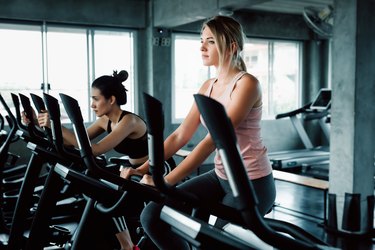
Using an exercise bike for the first time is your introduction to an effective way to get your cardiovascular workout either at home or in the gym. This form of exercise also strengthens your glutes, quads, hamstrings, hip flexors and calves. You'll find stationary exercise bikes in upright and recumbent models featuring an electronic readout that guides you through your workout.
Tip
Adjust the seat and handlebars when using an exercise bike for the first time. Maintain good posture and correct form throughout your workout to prevent injury.
Video of the Day
Correct Form to Prevent Injury
Cycling on a stationary bike is a safe activity, but you may still strain your muscles or develop overuse injuries if you don't use correct form during your workout. When you're using an exercise bike for the first time, begin by adjusting the seat. This simple step can make all the difference when it comes to injury prevention, according to a September 2015 interview with Matt Tinkey, MS, ATC for the University of Pittsburgh Medical Center Health Beat.
Video of the Day
Adjust the seat so that when you sit on the bike with your feet on the pedals, your knee is slightly bent at the bottom of the stroke. Then, move the seat forward or backward so that when the pedal is parallel to the ground, your front foot is positioned directly under your knee. Finally, adjust the handlebars so that there is no strain or pain in your back.
Warning
Knee pain is an indication that the seat is not in the correct position. Lower the seat if the pain is in the back of your knee and raise it if the pain is in the front of your knee.
Body Position While Cycling
During your workout, keep your abs engaged and your hips centered over the seat to avoid unnecessary twisting of your body. Poor posture can affect the effectiveness of your workout and increase injury risk. Common cycling overuse injuries may include tendonitis, calf and quadriceps muscle strains and back pain.
Maintain good cycling form by gripping the handlebars lightly with your entire hand to avoid strain and keeping your arms slightly bent at about a 15-degree angle, advises the University of Pittsburgh Medical Center. When you pedal, be sure you are both pushing down and pulling up as the pedals make a complete cycle. Adjust the resistance so that it is challenging for you, but not so difficult that you are risking injury.
If you feel pain in your muscles, back or joints while cycling, stop exercising immediately. Make sure your bike is properly adjusted and check your body position. If the pain continues, consult your doctor.
Stationary Bike Workout for Beginners
A proper warm-up and cool down will prepare your body for exercise and improve your recovery time. Warm up with about five to 15 minutes of light pedaling. This allows your body time to adapt to being in a state of motion, decreasing your chance of injury.
Tip
Most pre-programmed exercise routines and exercise classes with a trainer will prompt you to do a warm-up. If you’re using the Quick Start option, you’ll have to watch the timer and monitor yourself.
Read more: The 10 Best Stretches to Do Before Biking
Many exercise bikes will have pre-programmed options that make for an easy-to-follow stationary bike workout for beginners. This option takes the guesswork out of your routine, and you can choose the length and intensity that is best for you.
Cycling classes are also a good way to get a guided workout. Be sure to listen to your body and build up the intensity slowly. Alternatively, you can design your own program by manually adjusting the resistance and your pedaling speed, as the American Council on Exercise points out.
Read more: Stationary Bike Workout: How Long?
Cool down in the same way as your warmup with light pedaling to allow your heart rate to return to normal. When you get off the bike, be sure to stretch out your muscles. This includes not only your legs but also your chest and shoulders.
Warning
Consult your doctor before beginning a new exercise program. Cycling can be an intense cardio exercise, so be sure to stay hydrated before, during and after your workout.
- University of Pittsburgh Medical Center Health Beat: "Tips for Maximizing Your Indoor Cycling Workout"
- University of Pittsburgh Medical Center Health Beat: "Cycling FAQs With Matt Tinkey, Cycling Performance Specialist"
- Brookhaven National Laboratory: "Common Overuse Injuries Attributed to Cycling, and Ways to Minimize These Injuries"
- American Council on Exercise: "Build Your Own Indoor Cycling Workout Routines"